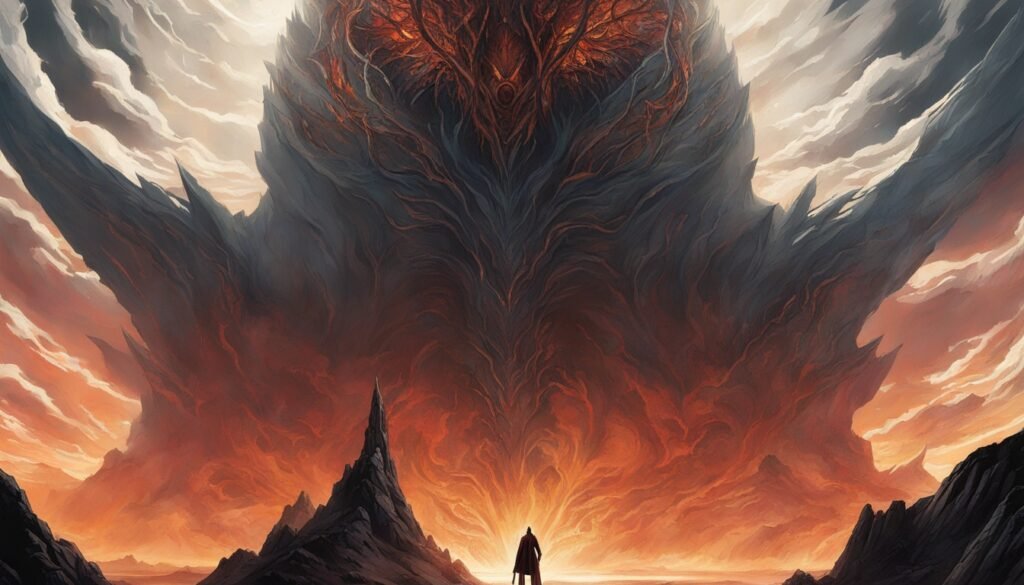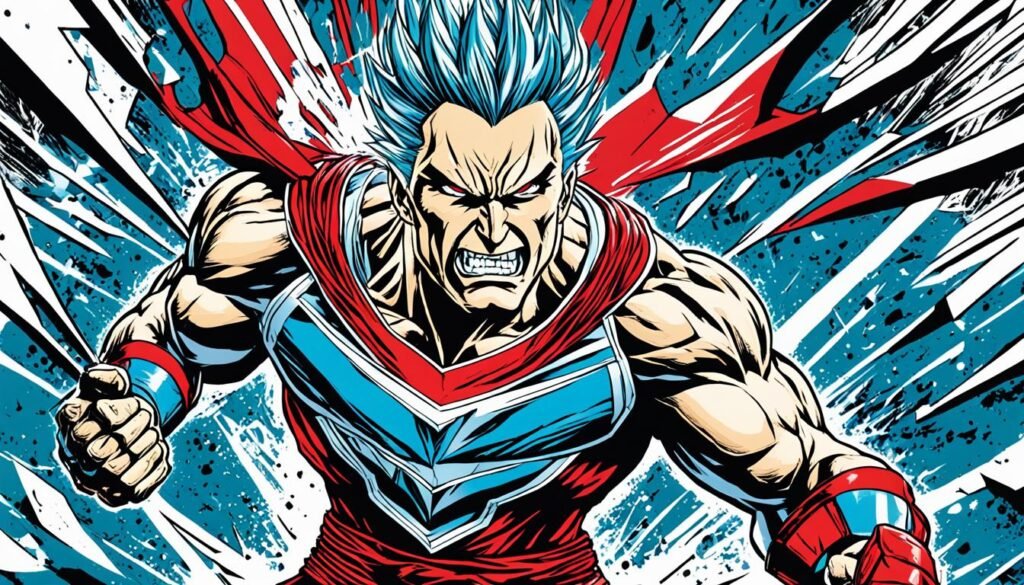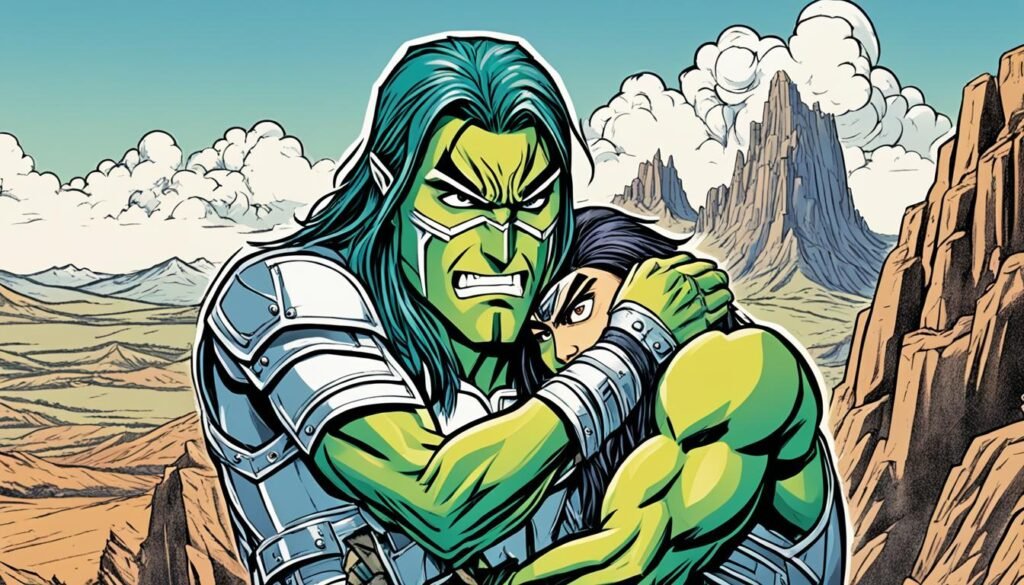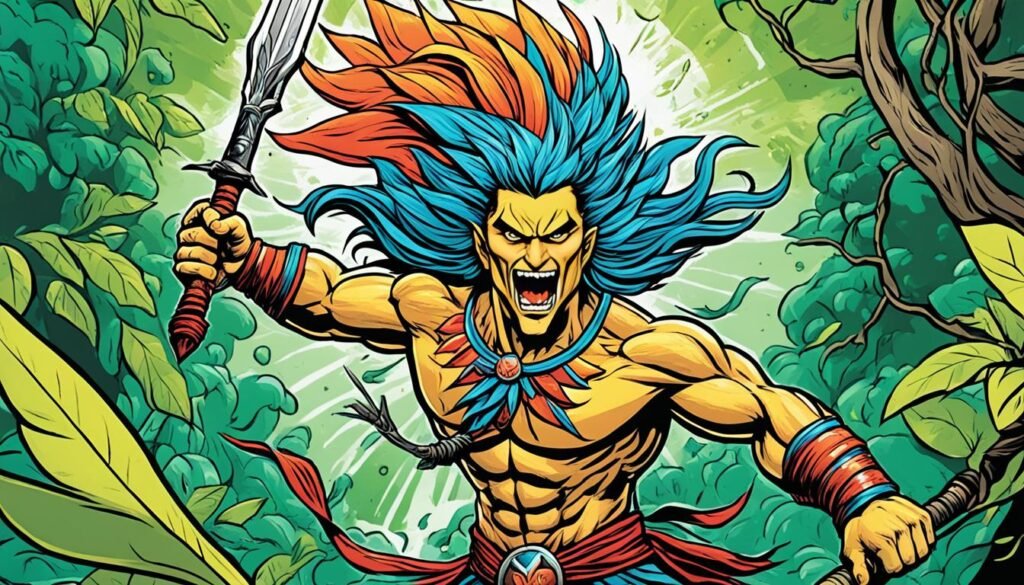In the heart of the Philippines, ancient Filipino folklore lives on. It’s here where the amazing story of Gaki and Lumawig unfolds. This Philippine mythology story tells us about the beginnings of the world. It takes us to a time long ago, showing us the role of the giant crab guardian, Gaki, in creating our landscapes.
It all started in an empty space, filled only with water, showing the passage of time. In this quiet world, Gaki, a giant crab, looked after the vast, empty lands. When travlers in this barren space cried out in need, they awoke Lumawig, the great god.
Their cries led Lumawig to act. He decided to fill the empty world with land to end their suffering. This marked the start of a new creation, a turning point led by Lumawig.
Key Takeaways
- The Gaki legend tells an amazing story from Philippine mythology. It reveals the early beginnings of our world.
- The story introduces the great god Lumawig and Gaki, the giant crab. They were key in creating the lands we know today.
- The Gaki legend explains how the world was created from nothing. It started with a void before everything we see now was made.
- Flooding, upon Lumawig’s order, brought up two mountains. It also saved the first people, Gatan and Bangan, from the water’s rise.
- The Gaki legend is a highly fundamental myth in Filipino folklore. It heavily influences the traditions and beliefs of the Philippines.
Primordial Beginnings
The world we know began in true desolation. Only the waters marked the passage of time. At the center was a deep pit, home to the giant crab guardian, Gaki. This Lumawig had chosen Gaki to watch over the world’s early days.
The Void and Desolation
Long before the earth, the world was an empty expanse with no features. The waters lay silent, stretching endlessly as time flowed. This looks different from the vibrant world we see now. It shows how much change was yet to come.
Gaki, the Giant Crab Guardian
In this early world, only Gaki watched over it. Lumawig picked Gaki to protect and keep the world in balance. Gaki ensured everything stayed in place until it was time for a big change.
Nomadic Humans and the Wrath of Lumawig
In ancient times, a new world was just born. It was vast and empty. Nomadic humans moved across it, looking for food. However, the land had no signs or features to guide them. Because of this, they often got lost and cried out in despair.
Wanderers Without Guidance
These nomads kept moving to survive. But, without homes or ways to navigate, they couldn’t find their way. Their constant wandering upset the peace of the new world. Their aimless movement worried everyone.
The Disturbed Slumber
God Lumawig was in a deep sleep, watching over the world’s dawn. The lost ones’ cries woke him. The noise was so loud it broke his peaceful sleep. He had to see what was happening below.
Lumawig’s Dream of a New Generation
Waking up, Lumawig saw the nomads wandering. He then had a grander idea. He wanted beings who would live in and shape the world. They shouldn’t just wander around. This made him decide to take action and guide the creation.

The Great Flood and Rebirth
Lumawig, the great god, saw humans causing too much trouble. He asked the giant crab guardian, Gaki, for help. Gaki then covered the pit with his body. This action caused a massive flood. It covered everything, cleansing the land. This way, a fresh start could happen.
Gaki’s Role in the Deluge
When Gaki filled the pit, waters started to rise. Everything became submerged. This was Lumawig’s plan to start anew. It washed away the old, making space for a better, peaceful time.
The Rise of Polis and Calawitan
After the flood, Mount Polis and Mount Calawitan emerged. They became the heart of Lumawig’s new world. These mountains guided and influenced the people who followed. They shaped the culture of the Philippines.
Gatan and Bangan: The Survivors
Some people were saved from the flood by Lumawig himself. Among them were Gatan and Bangan. They stood on Mount Polis. It was their duty to start life again on the earth.
Gaki
Gaki was the giant crab guardian in the Philippines’ creation myth. Lumawig, the great god, chose Gaki to watch over the world’s new beginnings. Gaki guarded the deep pit in a bleak land, where creation and destruction had to stay in balance.
In the Buddhist belief, gaki are spirits in the afterlife who are always hungry and thirsty. Their suffering mirrors their past sins. They may only eat blessed food or must eat unclean things like feces. The gaki realm, called Gakidō, is a barren wasteland. This reflects the deep spiritual pain felt by the gaki.
| Gaki Characteristics | Description |
|---|---|
| Eternal Hunger and Thirst | Gaki spirits constantly hunger and thirst because of their past wrongdoings. |
| Varied Torment | Gaki face different punishments based on what they did wrong. |
| Restricted Diet | Some can only eat blessed food; others must eat unclean things. |
| Gakidō Realm | Described as a desolate world with deserts, showing the spiritual pain of its inhabitants. |
During Obon, the segaki ceremony is done to help the gaki. This ceremony provides food and offerings to lessen their suffering. The gaki realm is seen as one of the four most difficult places in Buddhist cosmology.
The term “gaki” can also mean a hungry child. It comes from the gaki’s perpetual hunger in Buddhist stories. This shows how the legend of Gaki is deep and has many meanings, from spiritual pain to everyday language.

The Journey of Gatan
After the great flood, Gatan was lifted by Lumawig onto Mount Polis. He was alone, with no memory, staring at a flickering light in the distance.
Animal Companions and Divine Gifts
Gatan started walking towards the light. He soon met animals that seemed to guide him. These creature companions helped him find food, shelter, and a path through the strange land.
Gatan also received special gifts from Lumawig during his travels. These blessings allowed him to talk to animals. They also helped him understand nature and the gods’ will.
Arrival at Mount Calawitan
With the help of the animals and his divine gifts, Gatan made it to Mount Calawitan. He found the light was his sister, Bangan. She too survived the flood. They were both emotional to be together again and ready for the journey ahead.
The Forbidden Union
On Mount Calawitan, Gatan met his sister Bangan. They felt a strong bond as family right away. Being the last two people on earth, they had to repopulate it, even though they were brother and sister.
The Dilemma of Siblings
Gatan and Bangan faced a heart-wrenching choice. They shared a genuine love, but it was wrong according to society’s rules. Despite needing to come together for humanity’s future, their choice was against everything they believed in.
Lumawig’s Blessing
While struggling with their emotions, the god Lumawig appeared. He had previously saved them from the flood. Lumawig understood their situation and blessed their union.
This divine approval let Gatan and Bangan move forward as Earth’s new founders. With Lumawig’s support, they knew they could make a fresh start.

Unfolding of the New World
Gatan and Bangan began the new world. Lumawig asked Gaki to let the waters go. Then, the first features of the land appeared. Mountains, valleys, and rivers were born.
Gaki’s Withdrawal and Landscape Formation
When Gaki left his place, the waters pulled back. The land got its shape from these movements. It was a place full of mountains and rivers, just made.
The Gift of Vegetation
Lumawig made the land green as the waters went. He filled it with forests, fields, and many plants. This change brought life for all living beings, human and mythical alike.
Mythological Creatures of the Philippines
The Philippines is rich in mythological creatures. Each has its special traits and cultural meaning. There are many kinds, like the
Aswang and Shape-Shifters
, who have different forms. They can be vampires, weredogs, or ghouls that feed on the dead.
The country is also home to the
Diwata and Nature Spirits
. They include the Duwende, Engkanto, and Sirena. Duwende are small magical folk, Engkanto are beautiful beings without a philtrum, and Sirena are fish-tailed beings. They all add to the rich tapestry of legends.
Additionally, the Philippines has
Giants and Monstrous Beings
. This group includes Kapre and Bakunawa. Kapre are giant tree-dwelling creatures, while Bakunawa is a sea serpent. There’s also Sigbin, who looks like a goat with unique features. They are feared by many.
The Philippines’ mythological world shows its cultural wealth. With 140+ ethnic groups, its tales are diverse. From the scary Aswang to the magical Diwata and strong Giants, these stories are beloved and keep the Filipino spirit alive.
Cultural Significance and Influence
The legend of Gaki and Lumawig is very important to Filipinos. It is a key myth that shows their rich culture and beliefs. This story tells how the world began and why mythological beings are important in Filipino culture.
Gaki, the giant crab, and Lumawig, the god, are central figures in this myth. They played a big part in creating the earth. This story is well-known across the country, showing its deep impact.
This myth has influenced Philippine society in many ways. It has inspired art and literature. It has also helped keep traditional beliefs alive. The story continues to be told and studied, adding to its cultural importance.
The myth’s lasting impact shows the power of storytelling. It reminds Filipinos of their deep connections to myth and tradition. In a changing world, the Gaki and Lumawig legend remains a vital part of Filipino cultural identity.

Variations and Adaptations
The Gaki and Lumawig tale is well-known across the Philippines. It tells a story that has stayed the same at its heart. But, it changes in small ways as it reaches different regions and groups.
Regional Interpretations
In the Philippines, each area has its own take on Gaki and Lumawig. In the north, Gaki is seen as a protector of the land. There, stories may focus on keeping nature safe.
The central islands highlight stories of a big flood and how people survived it. In the south, spirituality mixes in, with tales of nature spirits and mythical beings. These versions show the diversity of Philippine tales and how they form the local culture.
Modern Retellings
Today, many artists and writers add their spin to the Gaki and Lumawig legend. They share the story in new ways, from books to videos. This helps people all around the world discover this ancient tale.
Looking at the many versions of this legend helps us see the beauty of Philippine mythology. It shows how these stories still captivate people today.
Preserving Oral Traditions
The Gaki and Lumawig legend’s legacy is deeply connected to the Philippines’ oral traditions. Generations have kept these mythological stories alive through tales. Elders and community members act as protectors of these narratives, passing them on.
Importance of Storytelling
Storytelling is key in keeping the Gaki and Lumawig legend relevant and culturally important. By sharing these stories from one generation to the next, the Filipino people stay connected to their past. This helps create a strong sense of who they are over time.
Efforts in Documentation
Lately, many have worked hard to document and save the Gaki and Lumawig legend. Scholars, researchers, and leaders from different communities have come together. They’ve gathered oral histories, done interviews, and written down these myths. These actions help ensure that this cultural wealth survives the years.
This work is about protecting the Gaki and Lumawig legend. But it’s also about learning more about Philippine mythology and folklore. By keeping these oral traditions, Filipinos can honor their culture uniquely. They can also share the amazing stories of their origins with those who come after them.
Exploring Gaki’s Legend Today
The Gaki and Lumawig legend remains popular today, drawing many to explore its meaning. Experts have looked closely at the story’s symbols, key characters, and themes. They show us the tale’s deep value and its place in both Filipino and worldwide culture.
Literary Analysis
Experts have pulled apart the Gaki and Lumawig legend to find its deep significance. They’ve shown how the story reflects what the Filipino people believe and value. This has helped uncover meanings beyond the simple story.
The giant crab, Gaki, is a key focus of their research. It’s seen as a symbol for balancing the material world with the spiritual one. Also, the Gaki-dō, or the Realm of the Hungry Dead, represents the effects of having unfulfilled desires.
Cultural Tourism
The Gaki and Lumawig story’s impact is seen in cultural tourism. Places linked to the legend, like the Gaki-dō and Mount Calawitan, are now key spots for visitors.
Travelers can enjoy tales, rituals, and even meet mythological beings thanks to tour operators and local hosts. This effort helps keep the story alive, while also teaching visitors about Filipino culture and the myth’s lasting importance.
Conclusion
The story of Gaki and Lumawig shows the amazing world of Philippine myths. It’s a tale of how everything began, changed, and was shaped by divine beings. This story has been loved for many years, forming a key part of the country’s traditions and tales.
This myth’s long-lasting charm highlights why we should keep and share stories like these. Stories about Gaki and Lumawig help teach us, still today. They show us the early days of the Philippines and its cultural ideas.
Looking closely at this myth, we find themes and people that seem familiar in different places. Gaki and Lumawig’s legend is a story anyone can understand. It asks questions that all people think about, from ancient times till now.
In our fast-changing world, keeping myths alive is more important than ever. By spreading the story of Gaki and Lumawig, we respect the deep culture of the Philippines. We also help others learn about the many mythologies that make our world rich and diverse.
FAQ
What is the Gaki and Lumawig legend?
Who are Gaki and Lumawig?
What happened during the primordial era?
How did the great flood shape the world?
Who were the first humans in the new world?
What other mythological creatures are present in Philippine folklore?
What is the cultural significance of the Gaki and Lumawig legend?
How has the Gaki and Lumawig legend been studied and interpreted today?
Source Links
- https://phspirits.com/gaki-tagalog-translation/
- https://en.wikipedia.org/wiki/Glossary_of_Shinto
- https://cryptidz.fandom.com/wiki/Creatures_and_Beings_of_Philippine_Folklore_and_Lower_Mythology
- https://mythus.fandom.com/wiki/Gaki
- https://pssc.org.ph/wp-content/pssc-archives/Philippine Sociological Review/1974/09_The Literature of Besao.pdf
- https://forum.evageeks.org/viewtopic.php?t=15461&start=100
- https://gutenberg.org/files/55473/55473-h/55473-h.htm
- https://corissajoy.com/origins-of-ghost-month/
- https://en.wikipedia.org/wiki/List_of_Philippine_mythological_creatures
- https://en.wikipedia.org/wiki/Philippine_mythology
- https://en.wikipedia.org/wiki/Japanese_popular_culture
- https://pdfs.semanticscholar.org/7a8d/188081ba7661625cc6430903f8db20082837.pdf
- https://en.wikipedia.org/wiki/Mosquito
- https://en.wikipedia.org/wiki/Hungry_ghost
- https://l5r.fandom.com/wiki/Gaki-dō
- http://www.gaki.gr/en/legal-terms
- https://the-true-tropes.fandom.com/wiki/Gaki_no_Tsukai_Ya_Arahende

